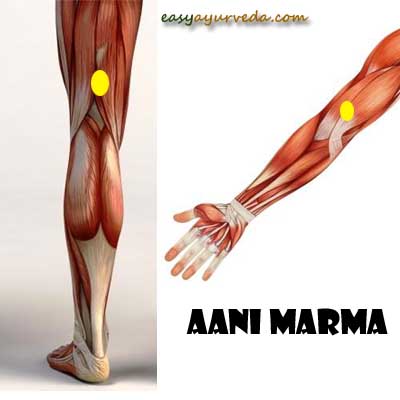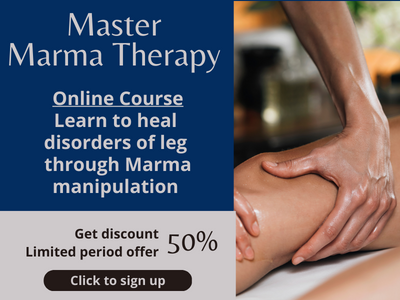Aani Marma: Anatomical Location, Effect Of Injury
Article by Dr Raghuram Y.S. MD (Ay) and Dr Manasa, B.A.M.S
Aani Marma is one of the delicate and vital points of the body located in the arms and thighs.
कूर्परौ ऊर्ध्वं उभयतः, त्रि अंगुलम् आणि नाम, तत्र शोफ अभिवृद्धिः स्तब्ध बाहुता च।(सु.शा.६)
जानुन ऊर्ध्वं उभयतः त्रि अंगुलम् आणि नाम, तत्र शोफा अभिवृद्धिः स्तब्ध सक्थिता च।(सु.शा.६)
Table of Contents
Location, number
Location –
Ani Marma is located both in upper and lower limbs, in the arms and thighs to be precise.

Number – Aani Marmas are 4 in number,
1 each in the right and left arm = 2
1 each in the right and left thigh = 2
Exact location of Aani Marma in the limbs:
In the upper limb – It is located 3 angulas above the Kurpara Sandhi (elbow joint), in both the arms.
In the lower limb – It is located exactly 3 angulas above the Jaanu Sandhi (knee joint), in both the legs.
Categories
Categories in which the Aani Marma is included
Aani Marma is classified into various categories. They are as below mentioned –
i) Shaka Gata Marma (Shaaka=Limb) – Since Aani Marma is located in both upper and lower limbs; they are classified under shaaka gata marmas i.e. Marmas located in the limbs.
ii) Snayu Marma – Aani marma is predominantly made up of Snayu i.e. tendons and nerves, which form the structural component of this Marma. Therefore it is classified under Snayu Marma. The other tissues are recessive are present in less proportion, namely Sira (blood vessels), Asthi (bone), Sandhi (joints) and Mamsa (muscles).
iii) Vaikalyakara Marmas – (Vaikalya – deformity, Kara – forming) – Aani Marmas on getting injured causes vaikalya or deformity of the structures in the hands (upper limb) or foot (lower limb) depending on the site of injury. Since Aani Marma causes deformity, it is classified under Vaikalyakara Marma (deformity forming Marma).
Measurement
Pramana (measurement of Aani Marma) –
Aani Marma occupies a space of ½ angula dimension (1 angula is approximately equal to the horizontal dimension or breadth of middle segment of one’s own middle finger)
Effect of Injury
तत्र शोफ अभिवृद्धिः स्तब्ध बाहुता च।(सु.शा.६)
तत्र शोफा अभिवृद्धिः स्तब्ध सक्थिता च।(सु.शा.६)
Injury to the Aani Marma causes Shopha abhivruddhi (massive swelling) and Stabdhata (stiffness) of upper and lower limbs.
If the injury is in the Upper limb, the symptoms are seen predominantly in the upper portion of the body. Injury of Aani Marma in the upper limb causes massive oedema or swelling and rigidity of the arm or upper limb. If the injury happens in the Aani Marma of the lower limb, it causes oedema and rigidity of the thigh or lower limb.
Modern perspective
Modern Perspective (Practical anatomy) of Aani Marma
Structures falling in the area of Aani Marma –
Upper Limb:
- Tendon of Biceps brachii muscle
- Brachial artery
- Median nerve
- Radial nerve
- Ulnar nerve
- Musculocutaneous nerve
- Biceps muscle
- Coraco-brachialis muscle
- Triceps muscle
Lower Limb:
- Quadriceps femoris muscle
- Blood vessels supplying to the knee joint
- Femoral nerve
We can see the muscles, blood vessels and other tissues too being present in this area comprising of Aani Marma but it is rich in ligaments, tendons and nerves. Therefore it is a Snayu Marma.
When the Aani Marma is injured, all the structures involved in any place of marma i.e. sira (blood vessels), asthi (bones), mamsa (muscles) and sandhi (joints) may be susceptible to get damaged but the snayu (ligaments or tendons) which chiefly make up the structure of Aani Marma tends to get injured to a severe extent in comparison to other structures. The impact of injury too will be chiefly due to the effect of injury to the snayu component.
Just Before Finishing
Stiffness and swelling in the thigh or arm shouldn’t be ignored since it may indicate damage or injury to Aani Marma. One should seek medical attention at the earliest in the presence of these symptoms of Aani Marma injury. This would surely prevent crippling or structural or functional deformity or impairment of upper or lower limbs.
Click to Consult Dr Raghuram Y.S. MD (Ayu)









